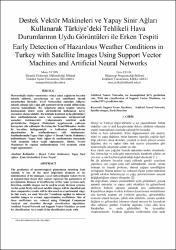| dc.contributor.author | Aydın, Musa | |
| dc.contributor.author | Çelik, Enes | |
| dc.date | 2014 | |
| dc.date.accessioned | 2014-12-26T08:19:30Z | |
| dc.date.available | 2014-12-26T08:19:30Z | |
| dc.date.issued | 2013 | |
| dc.identifier.citation | Aydin, M., Celik, E., "Early detection of hazardous weather conditions in Turkey with satellite images using Support Vector Machines and Artificial Neural Networks", IEEE 21. Signal Processing and Communications Applications Conference (SIU), Girne, Kıbrıs, 2013 | |
| dc.identifier.uri | https://hdl.handle.net/20.500.11857/360 | |
| dc.description.abstract | Meteorolojik olaylar sonucunda ortaya çıkan yağışların önceden tahmin edilerek, zararlarının en aza indirilmesi önemli unsurlardan birisidir. Yerel Meteoroloji radarları bölgesel tabanlı çalıştığı için yağış gibi parametrelerin temsil edilmesinde yetersiz kalmaktadır. Bu radarların erken tespitte yetersiz kalmasından ötürü uydu görüntülerini kullanarak karar sistemleri oluşturulabilir. Bu noktada kızılötesi uydu görüntüleri önce sınıflandırılacak sonra test aşamasında karşılaştırmalı sonuçları irdelenecektir. Çalışmamızda kızılötesi uydu görüntülerine Dalgacık Dönüşümü uygulanarak yaklaşım katsayıları elde edilmiştir. Bu katsayılar Temel Bileşenler Analizi ile boyutları indirgenmiştir ve kullanılan sınıflandırma algoritmaları ile sınıflandırmaya tabi tutulmuştur. Sınıflandırmada Yapay Sinir Ağları ve Destek Vektör Makineleri kullanılmıştır. Yapay Sinir Ağları ile sınıflandırma sonucunda %84 oranında erken tespit saptanmıştır. Destek Vektör Makineleri ile yapılan sınıflandırmada %93 oranında erken tespit saptanmıştır. | |
| dc.description.abstract | The prediction of meteorological phenomena resulting from rainfall, is one of the most important elements of the minimization of the damages. Local meteorological radars works at regional base hence they cannot represent the parameters of precipitation. Because of insufficiency of the radar systems early detection, satellite images can be used to create decision systems. At this point firstly infrared satellite images will be classified and then comparative results will be discussed on experimental stage. In this work, we used Wavelet Transform applied to infrared satellite images to extract approximation coefficients. Size of these coefficients are reduced using Principal Component Analysis and classified through classification algorithms. Artificial Neural Network and Support Vector Machines are used for classification. As a result of the classification made with Artificial Neural Networks, we accomplished 84% prediction rate. With the classification of Support Vector Machines, we reached 93% prediction rate. | |
| dc.language.iso | tur | |
| dc.relation.ispartof | Signal Processing and Communications Applications Conference | |
| dc.rights | info:eu-repo/semantics/openAccess | |
| dc.rights.uri | http://creativecommons.org/licenses/by/3.0/us/ | * |
| dc.subject | Destek Vektör Makineleri | |
| dc.subject | Uydu Görüntüleri | |
| dc.subject | Yapay Sinir Ağları | |
| dc.subject | Erken Tespiti | |
| dc.subject | Support Vector Machines | |
| dc.subject | Artificial Neural Networks | |
| dc.subject | Satellite Images | |
| dc.subject | Early Detection | |
| dc.title | Destek Vektör Makineleri ve Yapay Sinir Ağları Kullanarak Türkiye’deki Tehlikeli Hava Durumlarının Uydu Görüntüleri ile Erken Tespiti | |
| dc.title.alternative | Early Detection of Hazardous Weather Conditions in Turkey with Satellite Images Using Support Vector Machines and Artificial Neural Networks | |
| dc.type | presentation | |
| dc.department | Meslek Yüksekokulları, Babaeski Meslek Yüksekokulu, Büro Hizmetleri ve Sekreterlik Bölümü | |
| dc.relation.publicationcategory | Diğer | |





















